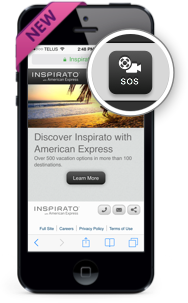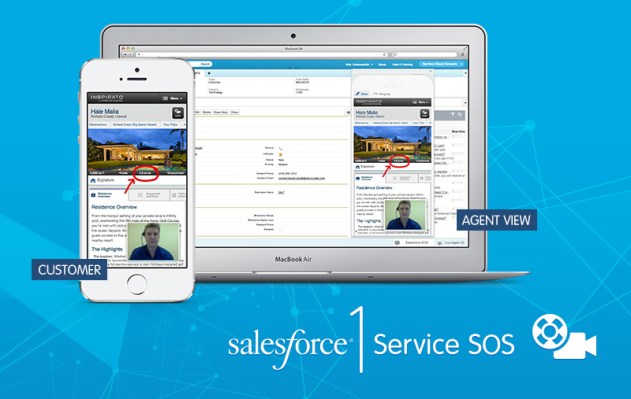Salesforce has poured a lot of investment into social and mobile products to make sure that its suite of cloud-based CRM services continues to find audiences where consumers are engaging online the most these days. Today it unveiled the latest move in that direction, Salesforce1 Service Cloud SOS — Service SOS for short — one-touch live video support and on-screen guided assistance for businesses that want to incorporate Amazon Mayday-style buttons so that users can talk with support agents when they have questions or problems with an app.
Salesforce says the SOS button will enter a private beta in the second half of 2014, with prices announced at general availability (the existing Salesforce1 Service Cloud starts at $65 per user per month). The SOS button, for now, is being targeted specifically at iOS and Android native apps.
Salesforce names several companies that were already using its Service Cloud products, such as Cars.com, Inspirato with American Express, Philips and Stanley Black & Decker, who are testing out the SOS button now.
The new hot button is an extension of the products that Salesforce has been offering for online businesses to feature in desktop web products in the form of Desk.com and Service Cloud. The latter of these made a big expansion into mobile last year, including mobile co-browsing and chat support among other new features. Desk.com, meanwhile, rebranded from its original name of Assistly in 2012 after Salesforce acquired it in 2011 for up to $80 million, as part of its push into offering small business users more social media-based CRM services.
 Salesforce says that businesses will be able to incorporate the button by way of a set of Platform APIs into any mobile app. Services that will be accessible include live video support, as well as one-way video. Additionally, one-to-one agent-guided assistance will also be available with users sharing mobile screens with agents. “The agent will see a mirror-image view of the customer’s screen and can draw on the screen to provide personalized step-by-step guidance,” Salesforce says.
Salesforce says that businesses will be able to incorporate the button by way of a set of Platform APIs into any mobile app. Services that will be accessible include live video support, as well as one-way video. Additionally, one-to-one agent-guided assistance will also be available with users sharing mobile screens with agents. “The agent will see a mirror-image view of the customer’s screen and can draw on the screen to provide personalized step-by-step guidance,” Salesforce says.
The impetus to extend its offerings into mobile comes from the fact that this is where Salesforce’s business customers need to be more responsive, and also because this is where current and potential Salesforce competitors are putting a lot of their efforts.
“The mobile phone has become the dashboard of our lives—we use it to manage how we interact with not only people, but products and companies,” Alex Bard, Salesforce’s EVP and GM of Service Cloud. “As the mobile device becomes every consumer’s channel of choice, it is important companies meet their customers where they are.”
Indeed, mobile app stores are predicted to see downloads of nearly 269 billion annually by 2017, according to Gartner, versus just under 64 billion today. Today the Apple app store is seeing downloads of 800 apps per second globally. For the most part, none of these users have much recourse for assistance when one of those apps goes wrong, or they simply get lost within it — an even bigger problem the further we get away from the majority of users being tech-savvy early adopters.
This is also an example of how Salesforce is intent on iterating in response to other software and cloud-friendly rivals in the field. Since Mayday’s launch in September 2013, Amazon has quietly been pushing and enhancing the service. Designed originally as a button that a Kindle Fire tablet user can push at any moment to get live assistance with whatever app is open, it’s taken on a life of its own, it seems, with CEO Jeff Bezos holding it up as an example of how the company has been, in his words, “reinventing normal.”
“Nothing gives us more pleasure at Amazon than “reinventing normal” – creating inventions that customers love and resetting their expectations for what normal should be,” he wrote in a shareholders’ letter earlier this month. “Mayday reimagines and revolutionizes the idea of on-device tech support. Tap the Mayday button, and an Amazon expert will appear on your Fire HDX and can co-pilot you through any feature by drawing on your screen, walking you through how to do something yourself, or doing it for you – whatever works best. Mayday is available 24×7, 365 days a year, and our response time goal is 15 seconds or less. We beat that goal – with an average response time of only 9 seconds on our busiest day, Christmas.
“A few of the Maydays have been amusing. Mayday Tech Advisors have received 35 marriage proposals from customers. 475 customers have asked to talk to Amy, our Mayday television personality. 109 Maydays have been customers asking for assistance with ordering a pizza. By a slim margin, Pizza Hut wins customer preference over Domino’s. There are 44 instances where the Mayday Tech Advisor has sung Happy Birthday to the customer. Mayday Tech Advisors have been serenaded by customers 648 times. And 3 customers have asked for a bedtime story. Pretty cool.”
In other words, without too much encouragement Amazon has found its “personal assistant” coming into its own as a service. And that’s before you consider the fact that, according to reports, Mayday is likely to get a big boost with the launch of the new Amazon Phone.
I suspect that Salesforce is interested in this partly a way of creating the kinds of services that enterprises want to have an control for themselves. But also partly as a competitive move. Since Amazon has made so many other inroads into cloud-based enterprise services through its AWS division, what’s to keep it from becoming even more of a competitive threat to Salesforce by launching an API version of Mayday for businesses to implement themselves?
